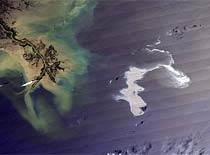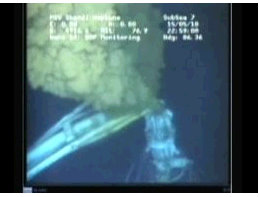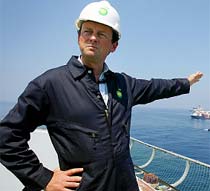So now it's obvious to everyone how difficult it is to drill a mile into the ocean for oil and then to fix it for leaks. So when it comes to predicting what happens next, or what is even happening now, maybe we shouldn't be surprised they don't have it down to a science (nevermind the rigorous application process that such a rig must go through). Still, it's fascinating – and a little scary – between what BP and the government say they think they know, and then what turns out to be the truth.
The following chart lists about 20 claims that have been already been either refuted or called into serious question in the last month and a half. This includes the now notoriously low 5000 barrels/day leak estimate, to BP CEO Tony Hayward's optimistic predictions on oil plumes and worker sickness that may turn out tragically off.

Where possible, I've included the dates to show how long it took for a claim to be disputed, and how long it took for the record to be corrected, if necessary. The left side of the chart lists the official statements; the right side lists the disputes and revelations in retrospect. Virtually all of the text below are verbatim selections from the linked sources.
No Oil is Leaking From the Deepwater Rig | |
April 23A Coast Guard official said that oil was not spilling from the deep-water well off the coast of Louisiana, apparently easing concerns of a potential environmental disaster days after the explosion left a one-by-five-mile sheen of oil on the Gulf of Mexico. “It does not appear that oil is emanating from the hole,†said Katherine McNamara, a fireman with the Coast Guard. (NYTimes) "We've been able to determine there is nothing emanating from the well-head," - Coast Guard Rear Admiral Mary Landry said on Good Morning America. 
|
April 24Robotic devices monitoring the deepwater well where a giant oil rig exploded and sank last week have discovered oil leaking from the well, a development that a senior Coast Guard official on Saturday called a “game changer.†The oil was coming from two places in the riser — the 5,000-foot pipe that connects the well at the ocean floor to the drilling platform on the surface. The rig, the Deepwater Horizon, which sank Thursday 50 miles off the coast of Louisiana, detached from the riser. Roughly 1,000 barrels of oil a day are estimated to be emanating from the riser, officials said. They said that both leaks were on the seabed. (NYTimes) |
The Blowout Preventer Will Work | |
April 22White House energy czar Carol Browner said in an interview she realized the situation was grave when the rig sank on April 22. But BP PLC had assured her that a blow-out preventer atop the well could be used to stanch the gusher, she said. (WSJ) 
|
April 29In an interview with "Good Morning America", BP COO Doug Suttles said the rig was equipped with some safety devices that should have prevented this kind of spill. "They didn't do that, we don't know why they didn't do that and ultimately we will find out," he said. (ABC) April 30On April 30, [Browner] learned that [blowout-preventer assurance] wasn't so, she said. (WSJ) A BP official said Friday that the device is designed to be activated by remotely operated submarines if it isn't triggered automatically. For at least the first week, that was the focus of efforts to stop the flow of oil. (WSJ) |
Oil is leaking 1,000 barrels/day | |
April 24Roughly 1,000 barrels of oil a day are estimated to be emanating from the riser, officials said. They said that both leaks were on the seabed. NYTimes 
|
April 27From the SkyTruth blog: We have a visible oil slick covering 2,233 square miles (5,783 km2). Given a minimum thickness of 1 micron (see chart below), that is 5,783 cubic meters of oil, or 1,527,706 gallons (36,374 barrels). The blowout happened almost 7 days ago on April 20. That's at least 5,000 barrels of oil per day. (SkyTruth) May 17BP Plc said it is capturing 1,000 barrels of oil a day from a mile-long pipeline connected to its leaking well in the Gulf of Mexico, about a fifth of the estimated flow rate. (Bloomberg Businessweek) |
OK, maybe the leak is 5,000 barrels/day | |
April 28In a hastily called news conference, Rear Adm. Mary E. Landry of the Coast Guard said a scientist from the National Oceanic and Atmospheric Administration had concluded that oil is leaking at the rate of 5,000 barrels a day, not 1,000 as had been estimated. (NYTimes) April 29Suttles told "Good Morning America" he still believes it to be between 1,000 barrels -- the company's original estimate -- and 5,000. 
May 14Robert Dudley, BP’s managing director, told MSNBC on Friday that the 70,000 barrel figure “feels like a little exaggeration, a little bit of scare-mongering...Five thousand [barrels] is a good estimate.†(MSNBC/The Hill) |

May 20"Now that we are collecting 5,000 barrels a day, it might be a little more than that." BP spokesman Mark Proegler told AFP |
OK, maybe we're not sucking up 5,000 barrels a day | |
May 20"It's now capturing 5,000 barrels per day of oil," BP spokesman Mark Salt, said. Previously, the company said it was capturing 3,000 barrels (126,000 gallons/573,000 liters) per day. (Reuters) 
|
May 21A BP spokesman told Reuters news agency on Friday that the company had only siphoned off 2,200 barrels, or 92,400 gallons, in the 24 hours up to midnight on Thursday. "The flow changes, it's not constant," BP spokesman John Curry said (BBC/Reuters). |
USGS: The spill is no more than 19,000 barrels/day | |
May 27Based on three separate methodologies, outlined below, the independent analysis of the Flow Rate Technical Group has determined that the overall best initial estimate for the lower and upper boundaries of flow rates of oil is in the range of 12,000 and 19,000 barrels per day. (U.S. Geological Survey) |
May 27, May 29"It would be irresponsible and unscientific to claim an upper bound," Ira Leifer, a researcher at the Marine Science Institute at the University of California, Santa Barbara, said in an interview. Dr. Leifer is a part of the National Incident Command's Flow Rate Technical Group, which produced the estimate. UC-Santa Barbara issued a statement Thursday in which Dr. Leifer said that "it's safe to say that the total amount is significantly larger" than 12,000 to 19,000 barrels a day. He urged that the statement be issued because "I wanted to stand up for academic integrity," he said in the interview. (WSJ) |
Measuring the Oil Spill Flow | |
May 10"There's just no way to measure it," said Kent Wells, a BP senior vice president, in a technical briefing Monday. (Environment News Service) 
|
May 13Richard Camilli and Andy Bowen, of the Woods Hole Oceanographic Institution in Massachusetts, who have routinely made such measurements, spoke extensively to BP last week, Mr. Bowen said. They were poised to fly to the gulf to conduct volume measurements. But they were contacted late in the week and told not to come, at around the time BP decided to lower a large metal container to try to capture the leak. That maneuver failed. They have not been invited again. (NYTimes) BP did not respond Thursday to a question about why Dr. Camilli and Mr. Bowen were told to stand down. Speaking more broadly about the company’s policy on measuring the leak, a spokesman, David H. Nicholas, said in an e-mail message that “the estimated rate of flow would not affect either the direction or scale of our response, which is the largest in history.†(NYTimes) June 3ProPublica discovers in BP's 582-page Oil Spill Response Plan for the Gulf of Mexico region, BP noted that in the case of an oil spill, determining its size and volume were “critical to initiating and sustaining an effective response.†|
BP claimed "worst-case scenario" is 162,000 barrels/day leak | |
February 2009In an exploration plan filed with the government in February 2009, BP said it had the capability to handle a "worst-case scenario" it described as a leak of 162,000 barrels per day from an uncontrolled blowout.(AP) |
May 11Bloomberg reports: In a regulatory filing BP made to drill the relief wells it estimates another blowout could release as much as 240,000 barrels of oil a day into the ocean. That’s almost 50 percent more than the company’s worst-case estimate for the first well. |
Impact to Beaches | |
March 2009In its environmental impact analysis, BP states "An accidental oil spill from the proposed activities could cause impacts to beaches. However, due to the distance to shore (48 miles) and the response capabilities that would be implemented, no significant adverse impacts are expected."
|
May 24, 2010[BP CEO] Hayward walked along oil-soaked Fourchon Beach and said he had underestimated the possible environmental effects.
|
Oil Floats. Ergo, No PlumesBecause of the depth of the leaking well, and the amount of chemicals used to break up the oil, scientists fear that the oil will slip under surface barriers | |

May 30CEO Tony Hayward said the company's sampling showed "no evidence" that oil was suspended in large masses beneath the surface. He didn't elaborate on how the testing was done. Hayward said that oil's natural tendency is to rise to the surface, and any oil found underwater was in the process of working its way up. "The oil is on the surface," Hayward said. "There aren't any plumes." (AP) 
|
May 15BP COO Doug Suttles to CNN: “So if it works as we have seen in the test, it should mean that there’s much less oil on the surface, which means our total dispersant usage will drop significantly and we should be able to monitor or report on that over the next few days.†May 27Scientists aboard a University of South Florida research vessel found an area of dissolved oil east of the leak that is about six miles wide, and extends from the surface down to a depth of about 3,200 feet, said Professor David Hollander. (Washington Post) May 28James H. Cowan Jr., a professor at Louisiana State University, said his crew on Wednesday found a plume of oil in a section of the gulf 75 miles northwest of the source of the leak. Cowan said that his crew sent a remotely controlled submarine into the water, and found it full of oily globules, from the size of a thumbnail to the size of a golf ball. Unlike the plume found east of the leak -- in which the oil was so dissolved that contaminated water appeared clear -- Cowan said the oil at this site was so thick that it covered the lights on the submarine. "It almost looks like big wet snowflakes, but they're brown and black and oily," Cowan said. The submarine returned to the surface entirely black, he said. (Washington Post) |
Where in the World is the NOAA Gordon Gunter? | |
May 15The NOAA Ship Gordon Gunter, previously scheduled to conduct plankton research in the Gulf of Mexico, is now providing information for oil spill related research NOAA 
|
May 18The commander of the NOAA vessel that the White House on Friday claimed in a press release "is now providing information for oil spill related research" told [the Huffington Post] on Tuesday that he's actually far away, doing something else entirely. "We are in the Western Gulf doing plankton research," said Commander Dave Score, reached by satellite phone on his research vessel, the Gordon Gunter. "So I really don't know. I'm just on orders." (Huffington Post) |
Testing the Cement SealA poor cementing job is one theory for how explosive gas escaped. BP claims it was unaware of any problems. | |
May 25BP told the Wall Street Journal that the tests weren't run because they were needed only if there were signs of trouble in the cement job, and the work seemed to go smoothly. 
|
May 25In a memo to Congress, BP's internal investigation found that "the float collar used in the cementing process did not initially operate as intended and required nine attempts with higher than usual pressures to function properly. Moreover, the float test performed after cementing may not have been definitive, leading to concern that there may have been contamination of the cement due to density differences between the cement and the drilling mud." (NOLA Times-Picayune) |
Who was the Decider on Deepwater? | |
April 29BP COO Suttles was quick to point out that another company was operating the rig at the time of the explosion, not London-based BP. April 30"This was not our accident," CEO Hayward told Reuters. "I can say that we had equipment required by the regulations," he said. "We don't know why, when the accident occurred, and I should probably clarify, the lease we are drilling on is owed by BP and a few other companies." ABC News May 3"This was not our drilling rig, it was not our equipment, it was not our people, our systems or our processes," CEO Hayward told the FT/BBC. 
|
May 16In an interview with 60 Minutes, Deepwater Horizon survivor Mike Williams claimed that BP managers had overruled Transocean in the well-sealing process: In the hours before the disaster, Deepwater Horizon's work was nearly done. All that was left was to seal the well closed. The oil would be pumped out by another rig later. Williams says, that during a safety meeting, the manager for the rig owner, Transocean, was explaining how they were going to close the well when the manager from BP interrupted. "I had the BP company man sitting directly beside me. And he literally perked up and said 'Well my process is different. And I think we're gonna do it this way.' And they kind of lined out how he thought it should go that day. So there was short of a chest-bumping kind of deal. The communication seemed to break down as to who was ultimately in charge," Williams said. (60 Minutes) 
May 26The rig's chief mechanic, Transocean's Douglas Brown, testified: "I recall a skirmish taking place between the company man... and the tool pusher and driller concerning the events of the day. The driller was outlining what was going to be taking place. Whereupon the company man stood up and said 'No. We have some changes to that.'" |
May 21The two BP executives read from a part of Transocean's Emergency Response Manual for the rig, emphasizing sections that stated that Transocean's offshore installation manager was "fully responsible" for activities onboard the rig, and BP's representative was there to "assist." (WSJ) |
May 21In response to BP's claims, Transocean provided The Wall Street Journal with a complete copy of the manual's well-control section. The well-control section stated that top managers on the rig for both BP and Transocean were supposed to jointly decide whether the situation was deteriorating to a point where they might lose control of the well. (WSJ) |
"No Precedent" of Blowout Preventers Failing | |
May 3"This is an unprecedented accident in terms of the failure of the blowout preventer. It is the ultimate safety system on any rig, and there is no precedent for them failing. So to get to this point, you've had to breach multiple safety systems and then have the ultimate device fail. So there is no precedent for failure" CEO Hayward told NPR 
|
May 8Accident reports from the U.S. Minerals Management Service, a branch of the Interior Department, show that the devices have failed or otherwise played a role in at least 14 accidents, mostly since 2005. In 1999...an MMS-commissioned report by a research group identified 117 blowout preventer failures at deepwater rigs within the previous year. These breakdowns created 3,638 hours of lost time - a 4 percent chunk of drilling time. In 2004, an engineering study for federal regulators said only 3 of 14 new devices could shear pipe, as sometimes required to check leaks, at maximum rated depths. Only half of operators accepting a newly built device tested this function during commissioning or acceptance, according to the report. "This grim snapshot illustrates the lack of preparedness in the industry to shear and seal a well with the last line of defense against a blowout," the report warned. (Associated Press) |
Top Kill, First Try | |
May 27, 5:43 a.m."Top kill" operations continued over the night & are ongoing. There are no significant events to report at this time. @BP_America "It's moving the way we want it to, but it's too early to say" BP Managing Director Robert Dudley to NBC's Today Show. "The fact that we had a bunch of mud going up the riser isn't ideal but it's not necessarily indicative of a problem," said spokesman Tom Mueller (MSNBC) May 28, 7:00 AM"Nothing has gone wrong so far" BP CEO Hayward tells CBS "The Early Show." Correction: This item had been mistakenly dated as May 27 |
May 26, 11 p.m.Operation began and was suspended after about 10 hours (NYTimes)...It was not until late afternoon that BP acknowledged that the operation was not succeeding and that pumping had halted at 11 p.m. Wednesday (NYTimes). 
|
Top Kill, Second Day | |
May 28“We have some indications of partial bridging, which is good news.†- BP CEO Hayward tells CNN. 
|
May 28BP suspended pumping operations at 2:30 a.m. Friday after two “junk shot†attempts to plug the leak with rubber and other materials, said a technician working on the operation, who spoke on condition of anonymity because he was not authorized to speak publicly about it, reported the New York Times A technician said that despite all the injections, at various pressure levels, engineers had been able to keep less than 10 percent of the injection fluids inside the stack of pipes above the well. (NYTimes) May 29"I don't think the amount of oil coming out has changed...Just by watching it, we don't believe it's changed." - BP chief operating officer Doug Suttles (Reuters) Reporters received a note from a BP spokesman saying information on the top kill is now considered "stock-market sensitive" and updates can be provided only in "formal settings," though BP's CEO made the rounds of morning news shows after that to talk about it. (CBS News) |
Media Access | |
May 20BP and Coast Guard don't have any rules that prohibit media access. Please see USCG response to the story here http://bit.ly/ae8cZ1 #BP (@BPAmerica) May 22"Neither BP nor the U.S. Coast Guard, who are responding to the spill, have any rules in place that would prohibit media access to impacted areas and we were disappointed to hear of this incident. The only time anyone would be asked to move from an area would be if there were safety concerns, or they were interfering with response operations. This did occur off South Pass Monday which may have caused the confusion reported by CBS today." (Coast Guard press release) |
May 2According to a contract obtained by News21, cleanup workers had to sign a contract, efective May 2, agreeing not to speak to the media or risk losing their jobs. The gag clause was apparently rescinded on May 24, according to News21. May 25Belle Chasse, La.-based Southern Seaplane Inc., which was scheduled to take a New Orleans Times-Picayune photographer for a flyover, says it was denied permission once BP officials learned that a member of the press would be on board. (Newsweek) |
Testing the Blowout Preventer | |
April 28Mr. Hayward said the blowout preventer was tested 10 days ago and worked. He said a valve must be partly closed, otherwise the spillage would be worse. (NYTimes) |
May 29The New York Times reports: Company officials asked for permission to delay their federally mandated test of the blowout preventer, which is supposed to occur every two weeks, until the problems were resolved, BP documents say...When the blowout preventer was eventually tested again, it was tested at a lower pressure — 6,500 pounds per square inch — than the 10,000-pounds-per-square-inch tests used on the device before the delay. It tested at this lower pressure until the explosion. To be fair, Hayward only claimed that the blowout preventer passed a test. He didn't say the test itself hadn't changed. |
How Far Was BP Drilling? | |
BP's permit allowed it to drill to 20,000 feet deep. |
Lawyers representing groups suing BP claim that "at least one worker who was on the oil rig at the time of the explosion on April 20, and who handled company records for BP, said the rig had been drilling deeper than 22,000 feet." (NYTimes) “The allegation surrounding the permitted depth is factually incorrect,†said Andrew Gowers, a BP spokesman. Mr. Gowers said that the rig was permitted to drill to 20,211 feet and that it drilled to 18,360 feet. (NYTimes) |
Workers Bused in for Pres. Obama Photo Op? | |
May 28Early Friday morning, "a number of buses brought in approximately 300 to 400 workers that had been recruited all week," Jefferson Parish Councilman Chris Roberts told CNN's "Situation Room." Roberts said the workers were offered $12 an hour to come out to the scene at Grand Isle and work in what he called a "dog and pony show." But, when Obama departed, so did the workers, he said, adding that he's never seen more than 20 workers at the Grand Isle cleanup site since the effort started. (CNN) "The sheriff's office did manage to get one person to speak with them and that individual said they were hired yesterday and told to report to a staging area at 7:30 this morning," Roberts added. "It just doesn't add up." |
May 28BP COO Doug Suttles downplayed the claim Friday evening, telling CNN it is not unusual to see people wrapping up work in the afternoon. (CNN) 
|
Cleanup Workers Getting SickBP has used hundreds of thousands of gallons of chemicals to disperse oil in the water. The chemicals have been banned in the UK and have been linked to illness in humans at high doses. | |

May 31BP CEO Hayward to CNN: "I'm sure they were genuinely ill, but whether it was anything to do with dispersants and oil, whether it was food poisoning or some other reason for them being ill," Hayward said. "You know, food poisoning is clearly a big issue when you have a concentration of this number of people in temporary camps, temporary accommodation. It's something we have to be very, very mindful of. It's one of the big issues of keeping the army operating. You know, armies march on their stomachs." (Times-Picayune) |
April 30The exact makeup of the dispersants is kept secret under competitive trade laws, but a worker safety sheet for one product, called Corexit, says it includes 2-butoxyethanol, a compound associated with headaches, vomiting and reproductive problems at high doses. “There is a chemical toxicity to the dispersant compound that in many ways is worse than oil,†said Richard Charter, a foremost expert on marine biology and oil spills who is a senior policy advisor for Marine Programs for Defenders of Wildlife. ProPublica |


